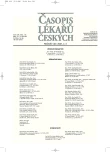Genetic Background of Mitochondrial Diabetes
Genetické příčiny mitochondriálního diabetu
Diabetes mellitus 2. typu je heterogenní onemocnění charakterizované porušenou glukózovou homeostází. Častý familiární výskyt poukazuje na genetickou příčinu onemocnění, nicméně přesný mechanizmus vzniku je dosud neznámý. Z mnoha studií je zřejmé, že přenos diabetes mellitus 2. typu v rodokmenech je častější po mateřské linii. Jedním z celé řady možných vysvětlení této skutečnosti je výhradně mateřský přenos mitochondrií. Tyto organely jsou odpovědné za energetický metabolizmus buňky. Při oxidačně–redukčních pochodech v dýchacím řetězci vyrábějí molekuly adenozintrifosfát. Obsahují vlastní genom, který kóduje podjednotky dýchacího řetězce a proteosyntetický aparát pro proteiny kódované tímto genomem. Patogenní mutace v mitochondriální DNA mohou ovlivňovat aktivitu dýchacího řetězce a různě se projevovat ve fenotypu. Mitochondriální diabetes často doprovází syndromy postihující nervovou a pohybovou soustavu a projevuje se neautoimunitním poškozením beta buněk pankreatu. Přestože mutace v mitochondriální DNA vedou k diabetes mellitus, jejich nízká frekvence v populacích nemůže vysvětlit častěji popisovaný maternální přenos diabetes mellitus 2. typu.
Klíčová slova:
mitochondriální DNA, mitochondriální diabetes mellitus, diabetes melitus 2. typu, transferová RNA.
Authors:
M. Vaňková; P. Lukášová; A. Zemanová; J. Včelák; D. Vejražková; I. Mazura 1; B. Bendlová
Authors‘ workplace:
Endokrinologický ústav, Praha
; Přírodovědecká fakulta Univerzity Karlovy, Praha
1
Published in:
Čas. Lék. čes. 2007; 146: 235-239
Category:
Review Article
Overview
Diabetes mellitus type 2 represents a heterogenous disease characterized by impaired glucose homeostasis. The disorder clusters in families suggesting genetic disposition, however the mechanism underlying is unknown. Many studies show more frequent maternal transmission of diabetes in the families. One of huge range of explanation is exclusively maternal transmission of mitochondria. Mitochondria are power organelles which produce ATP molecules by oxidation-reduction reactions via the respiratory chain. They contain their own genome which codes subunits of the respiratory chain and proteosynthetic apparatus for proteins encoded by this genome. Pathogenic mutations of mitochondrial DNA can affect the activity of the respiratory chain and result in various phenotypes. Mitochondrial diabetes is commonly associated with neuromuscular disorders and often presents with nonautoimmune beta cell failure. Although mitochondrial mutations are associated with diabetes, their low frequency does not explain reported more frequent maternal transmission of diabetes mellitus type 2.
Key words:
mitochondrial DNA, mitochondrial diabetes, diabetes mellitus type 2, transfer RNA.
Labels
Addictology Allergology and clinical immunology Angiology Audiology Clinical biochemistry Dermatology & STDs Paediatric gastroenterology Paediatric surgery Paediatric cardiology Paediatric neurology Paediatric ENT Paediatric psychiatry Paediatric rheumatology Diabetology Pharmacy Vascular surgery Pain management Dental HygienistArticle was published in
Journal of Czech Physicians

- Metamizole vs. Tramadol in Postoperative Analgesia
- Metamizole at a Glance and in Practice – Effective Non-Opioid Analgesic for All Ages
- Advances in the Treatment of Myasthenia Gravis on the Horizon
- Metamizole in perioperative treatment in children under 14 years – results of a questionnaire survey from practice
- Possibilities of Using Metamizole in the Treatment of Acute Primary Headaches
Most read in this issue
- Neurosteroids and Their Function
- Relationships Between the „Eating Inventory“ Factors, Socioeconomic Status, Anthropometric Body Adiposity Indexes and Health Risks in Czech Population
- Obesity Based on Mutation of Genes Involved in Energy Balance
- Growth Hormone Treatment in the Institute of Endocrinology
